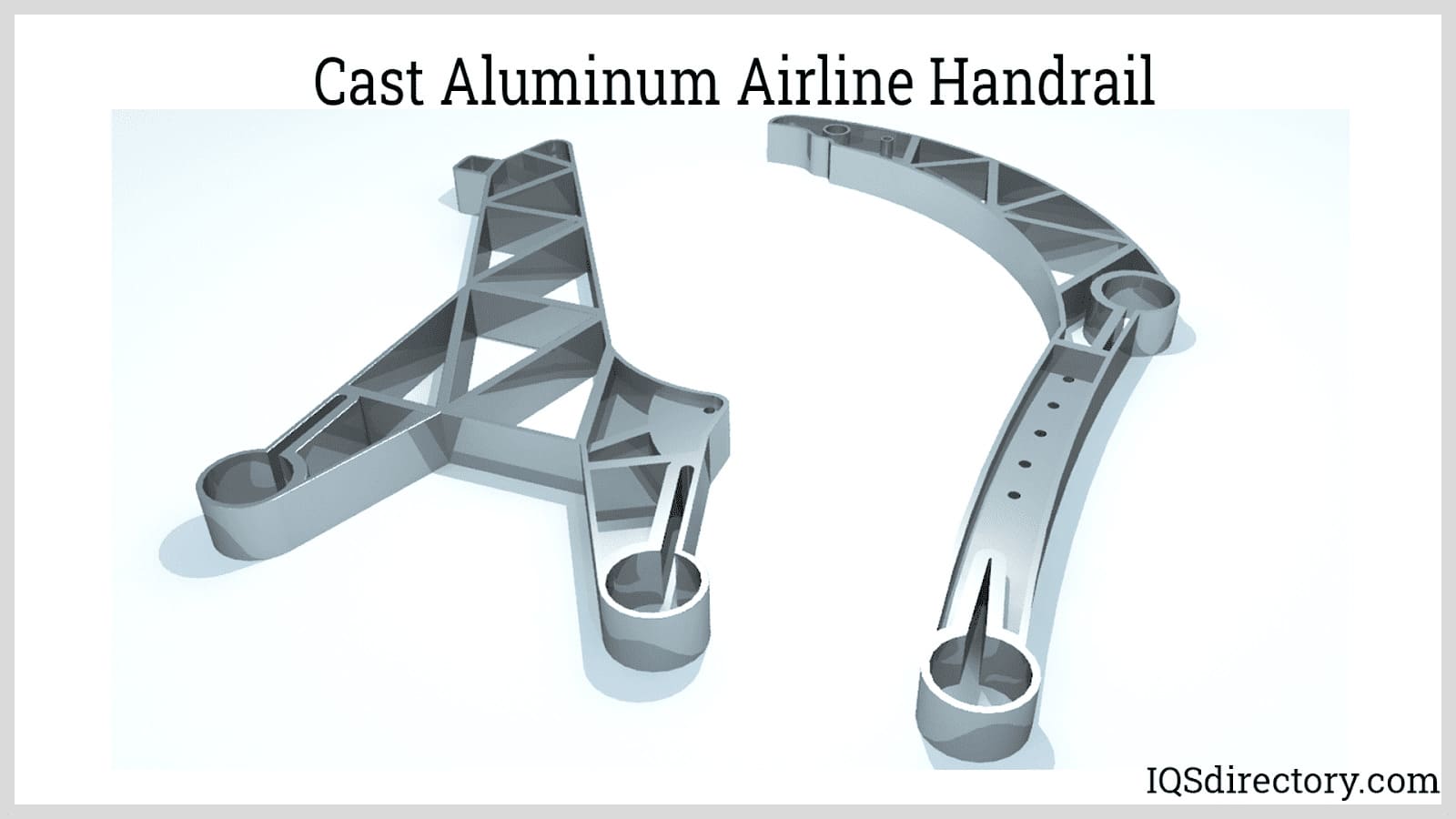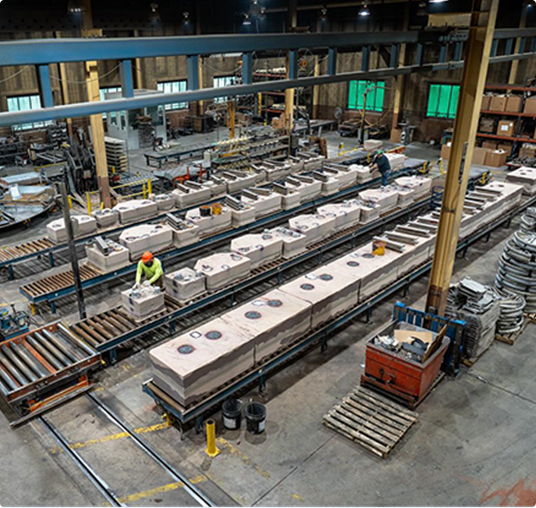The emerging opportunities for Aluminum Castings in global industries
Exploring the Benefits and Techniques of Aluminum Casting in Modern Production
Aluminum casting has become a pivotal method in modern production. Its light-weight properties improve power performance and decrease transport costs. Furthermore, innovations in casting methods allow detailed styles and fast prototyping. The advantages prolong beyond mere efficiency - Aluminum Castings. The sustainability of aluminum casting processes presents significant ramifications for different markets. Understanding these facets can reveal the transformative impact of aluminum in modern manufacturing techniques. What further developments could redefine its function?
The Lightweight Benefit of Aluminum Casting
Aluminum casting offers a considerable lightweight advantage that is transforming industries reliant on long lasting yet manageable products. This home is especially useful in industries such as automotive and aerospace, where every ounce counts in performance and fuel performance. The reduced weight of aluminum parts permits improved handling, reduced transport prices, and boosted power efficiency during operation. Unlike heavier steels, aluminum supplies an equilibrium of stamina and lightness, making it an optimal choice for complex applications that demand high efficiency without compromising structural integrity. Furthermore, the corrosion resistance of aluminum expands the lifespan of actors parts, decreasing the requirement for regular replacements. This combination of lightweight features and longevity positions aluminum casting as a crucial innovation in modern production procedures, motivating advancement and supporting the advancement of innovative products that fulfill the developing needs of various markets.
Boosted Style Adaptability and Complexity
Design adaptability and complexity are considerably improved through using aluminum casting, allowing makers to create elaborate forms and types that were formerly unattainable with conventional techniques. This capability allows the manufacturing of elements with thorough geometries, such as complicated internal flows and thin-walled frameworks, which can significantly boost the efficiency of the final item.
Additionally, aluminum casting techniques, such as die casting and sand casting, facilitate fast prototyping, allowing designers to repeat and improve their concepts swiftly. The ability to produce customized molds likewise adds to far better placement with particular style needs, reducing product waste and minimizing the demand for considerable machining.
Furthermore, the lightweight nature of aluminum complements its layout adaptability, as it permits for both visual allure and practical effectiveness. In general, the improvements in aluminum casting supply makers with the tools to push the limits of design, promoting advancement throughout various markets.

Superior Thermal and Electric Conductivity
Aluminum's superior thermal and electrical conductivity makes it an important material in various production applications. Compared to various other steels, aluminum provides significant advantages, specifically in warm dissipation and electric effectiveness. Aluminum Castings. This building enables its widespread use in sectors ranging from automobile to electronics, enhancing general performance and dependability
Thermal Conductivity Advantages
A vital benefit of aluminum casting lies in its superior thermal and electrical conductivity, making it a suitable option for various applications in contemporary production. The high thermal conductivity of aluminum permits reliable warmth dissipation, which is crucial in industries such as automobile and electronic devices. Components crafted from aluminum can successfully manage temperature changes, extending the life expectancy of items and boosting performance. This quality also makes it possible for producers to create lightweight designs without compromising thermal effectiveness. In addition, aluminum's capacity to withstand thermal biking better strengthens its setting popular environments. As industries significantly focus on power efficiency and efficiency, the thermal conductivity benefits of aluminum casting come to be increasingly considerable in driving technology and sustainability.
Electric Conductivity Applications
The electrical conductivity of aluminum matches its thermal properties, making it a valuable product in numerous applications within modern production. This conductivity makes it possible for effective power transfer, which is essential in electric parts such as circuitry, ports, and circuit card. Aluminum's lightweight nature even more improves its allure in applications where reducing weight is important, such as in aerospace and vehicle sectors. In addition, aluminum casting enables the development of complicated shapes, optimizing the efficiency of electric gadgets. The material's resistance to rust and oxidation likewise adds to long life in electrical settings, guaranteeing integrity. On the whole, aluminum's remarkable electrical conductivity settings it as a recommended selection in markets that demand high efficiency and performance in their electrical applications.
Comparison With Other Steels
While aluminum is renowned for its superior thermal and electric conductivity, it is important to compare its residential or commercial properties with those of other metals to recognize its benefits completely. Copper, for instance, exhibits even greater electric conductivity, making it better in specific applications like electrical wiring. Copper's weight and price can limit its use. In comparison, aluminum supplies a beneficial equilibrium of conductivity, weight, and affordability, making it perfect for lots of manufacturing applications. Additionally, aluminum's thermal conductivity is usually above that of stainless steel and titanium, which are frequently made use of in high-temperature atmospheres. Inevitably, aluminum sticks out not just for its conductivity but likewise for its lightweight and corrosion-resistant properties, making it a flexible choice in modern production.
Cost-Effectiveness and Reduced Material Waste
Taking full advantage of cost-effectiveness and reducing material waste are important advantages of aluminum casting in contemporary production. Aluminum's lightweight nature contributes to lower delivery prices and energy consumption throughout manufacturing. Additionally, its exceptional recyclability indicates that scrap product generated during the casting process can be reused, greatly minimizing the total product costs.
In addition, aluminum casting methods frequently enable for complicated shapes to be generated with less second operations, which simplifies the manufacturing process and decreases labor expenses. The capability to produce specific elements lowers the demand for excessive machining, further decreasing waste.
Companies embracing aluminum casting gain from decreased manufacturing time and enhanced performance, leading to total price financial savings. This mix of lower material costs, reliable reusing techniques, and reliable production processes placements aluminum casting as an economically advantageous option in the competitive landscape of modern production.
Advancements in Aluminum Casting Techniques
Recent developments in aluminum casting methods are changing the production landscape. Technologies such as the combination of additive manufacturing, enhanced mold designs, and environment-friendly casting procedures are driving effectiveness and sustainability. These developments not just enhance blog product quality but likewise lower environmental impact in the aluminum casting market.
Additive Production Assimilation
Additive manufacturing is changing aluminum casting methods by allowing the manufacturing of intricate geometries and lightweight structures that were previously unattainable. This assimilation enables suppliers to take advantage of 3D printing innovations to create complex molds and cores, which facilitate the casting of detailed designs with enhanced accuracy. Furthermore, additive manufacturing decreases material waste and shortens lead times, making it a much more lasting and effective method. Because of this, business can react a lot more rapidly to market demands and personalize products to satisfy particular customer requirements. This synergy between additive production and aluminum casting not only enhances style versatility yet also positions suppliers to introduce continually, driving improvements in performance and product performance within the affordable landscape of modern manufacturing.

Enhanced Mold And Mildew Layout
As manufacturers seek to enhance efficiency and item top quality, developments in mold and mildew design have emerged as an essential aspect in contemporary aluminum casting techniques. Advanced mold products, such as silicon carbide and graphite, enhance thermal conductivity and sturdiness, enabling faster cooling and improved surface finishes. Additionally, the assimilation of computer-aided design (CAD) technology makes it possible for precise mold geometries, promoting intricate forms that were formerly testing to accomplish. Technologies like 3D-printed molds also give fast prototyping capacities, lowering preparations significantly. Additionally, modular mold and mildew styles enable less complicated adjustments and repair work, minimizing downtime during production. Collectively, these improvements not only simplify making processes yet likewise add to the overall quality of aluminum actors items, satisfying the evolving needs of numerous markets.
Eco-Friendly Casting Processes
While the aluminum casting industry remains to evolve, a growing emphasis on sustainability has actually brought about the development of eco-friendly casting processes. These cutting-edge methods intend to lower environmental effect by reducing waste and power consumption. One noteworthy approach entails making use of recycled aluminum, which considerably reduces the carbon impact related to raw product removal. Additionally, developments in mold and mildew materials and designs allow for much more important site efficient heat transfer, reducing power demands during manufacturing. Water-based coverings and binders change traditional solvents, additionally lowering hazardous emissions. Additionally, some manufacturers are taking on closed-loop systems, ensuring that waste materials are recycled within the production cycle. Collectively, these environmentally friendly casting refines not only improve sustainability however likewise add to a much more accountable production landscape.
Sustainability in Aluminum Casting Processes
Sustainability in aluminum casting procedures has actually ended up being a centerpiece for suppliers intending to minimize their environmental impact. The industry is significantly adopting methods that lessen waste and improve source performance. One substantial technique includes the usage of recycled aluminum, which calls for just a portion of the energy required to create new metal from ore. This not just conserves sources yet additionally decreases greenhouse gas emissions connected with manufacturing.
Advancements in innovation have led to more energy-efficient casting approaches, such as low-pressure and gravity casting, which maximize product use and minimize power usage. Aluminum Castings. Suppliers are additionally applying closed-loop systems that permit the recycling of scrap product produced during the casting process. Additionally, making use of eco-friendly layers and lubricating substances even more adds to a more sustainable procedure. In general, these initiatives show a dedication to environmental stewardship while maintaining the high quality and effectiveness of aluminum casting
Applications of Aluminum Casting Across Industries
Aluminum casting finds extensive applications throughout different markets due to its lightweight, stamina, and flexibility. In the vehicle industry, aluminum castings are used to generate engine blocks, transmission housings, and wheels, boosting gas effectiveness this post while minimizing discharges. The aerospace sector utilizes aluminum castings for architectural elements, taking advantage of their high strength-to-weight proportion, which is important for flight safety and security and performance.
In the consumer electronics sector, aluminum spreadings are utilized for housing and structural elements, supplying sturdiness and aesthetic allure. In addition, the construction sector leverages aluminum castings for architectural components and components, profiting from their resistance to corrosion.
The marine sector includes aluminum castings in boat structures and engine parts, showing its suitability for extreme settings. On the whole, the varied applications of aluminum casting highlight its importance in contemporary production, adding to advancement and efficiency throughout numerous areas.
Frequently Asked Inquiries
What Are the Usual Alloys Made Use Of in Aluminum Casting?
The typical alloys made use of in aluminum casting include 413, 356, and A380. These alloys are valued for their excellent fluidness, toughness, and corrosion resistance, making them ideal for numerous applications in manufacturing and design.
Just How Does Aluminum Casting Contrast to Other Casting Approaches?
Aluminum casting offers one-of-a-kind advantages over various other casting methods, such as lighter weight, exceptional deterioration resistance, and exceptional thermal conductivity. It additionally permits detailed styles and faster production times contrasted to typical products like iron or steel.
What Is the Normal Life-span of Aluminum Cast Products?
The regular lifespan of aluminum actors items varies, normally ranging from 20 to half a century, depending upon elements such as ecological problems, maintenance, and particular applications. Proper treatment can significantly expand their resilience and efficiency.
Exist Any Health And Wellness Dangers Connected With Aluminum Casting?
The inquiry of wellness threats connected with aluminum casting emerges as a result of potential exposure to aluminum dirt and fumes. Extended inhalation might bring about respiratory concerns, emphasizing the significance of appropriate security actions during the casting procedure.
Just How Can Defects Be Reduced in Aluminum Casting?
To lessen defects in aluminum casting, suppliers can execute stringent quality assurance actions, optimize mold styles, keep proper temperature level control, utilize suitable alloy compositions, and use effective cleaning techniques to guarantee a defect-free casting procedure.